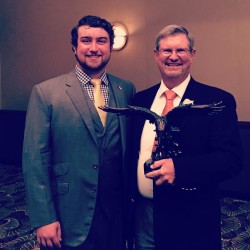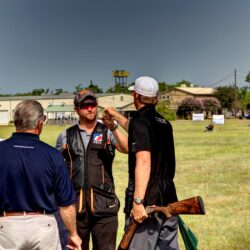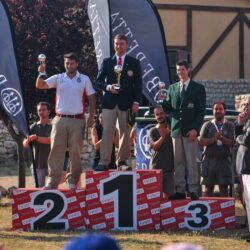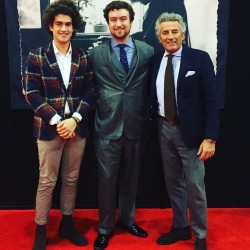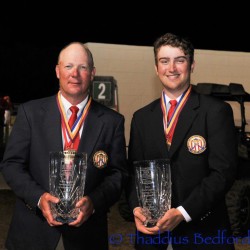This article was written in 2016, and while it does reflect the stage of knowledge and mindset I was in at the time — my own personal self improvement as a competitor, coach, and student of the game itself has influenced a change in some of the views expressed here. I am leaving this article up on my website, as it still is immensely valuable.
When shooting, do you look directly at the bird when pulling the trigger, or do you take your eyes off the bird prior to shooting? In essence, where are your eyes focused when you are finalizing the shot?
This really is a great question! I have attempted to quickly answer it many times in online threads on internet forums, but I am excited to get a chance to really dig deep into this topic.
The debate over where we focus our eyes as we finalize a shot is going to be one that is argued over and over again until we run out of arguments – and then it will just start over from the beginning. Most of the time when reading well-prepared responses to this question, all I get from them are, “Person X does this, and Person Y does this, and because Person Y has won more titles, we should do what Person Y does – because that is clearly the right answer.” But when have we ever really heard from Person X or Person Y personally? Frankly, I haven’t. My goal with this response is to give you a formulated answer that does not rely on the claim that certain people do what I am telling you – but instead, will rely on proven science or researched facts that have been proven day in and day out. But rest assured, people do what I am telling you. I also want to attempt to draw a parallel between shooting and other activities that can require the same type of skill set to complete. Hopefully, with this type of answer I will be able to better explain the reasoning behind my personal knowledge on this topic.
First, let me define what I mean by the word “shot”. When talking about “the shot”, I do not mean the moment in time when I pull the trigger. The entire “shot” is defined by the time the target begins to move on the plate of the machine until the time that I pull the trigger and the target is dead.
Let me now define what I mean by focus. It is my belief that probably around 90% (if not more) of the people who shoot clay target sports below that of the professional level do not fully understand what actually being focused on the target means. It does not mean that you can see the target well. It does not even mean that you can see rings on the target. When I am focused on the target – I can tell you how many rings it has, where the shadows are on each ring, where the shadow is on the dome, where the reflection from the sun is on the target, if it has wet spots on it, what direction it is spinning, where the black meets the orange paint, where the belly is, the dome inside the belly, the reflection off the inside of the belly, etc. Not only that, but when I truly focus on a target, it visually slows down immensely and seems to appear much larger than it really is. All of these are aside of the information that I would pick up from reading the target as well.
To start things off quickly – I personally am focusing directly on the bird/target the whole time throughout the shot. Beginning, middle, and end. I know from experience with my clients that a lot of people look in a “general area” at the beginning of the shot and hope that the target crosses their eyes to pick it up – in an attempt to not “waste their eyes” over a course of a tournament by looking at the bird the entire flight path. Although this is a commonly taught method, it really prohibits the shooter’s ability to synchronize with the target due to the fact that some of the most vital information about the target is picked up visually early on in the flight path. By eliminating this opportunity, the shooter is forced to add “reading the target” to the list of things to do in the second half of the flight path – where all they should be doing is focusing on the target.
Ever noticed how when you don’t quite see the target early on in the flight path and all of a sudden it sneaks up on you, everything seems to be in a rush and your mental state seems to be more elevated and conscious? Sometimes you actually even have a conscious thought process throughout that whole shot because you’re telling yourself to catch up to the target. Shooting should be executed on the subconscious level – just like swinging a golf club, hitting a baseball, throwing a pitch, and throwing or catching a football. Once you bring conscious thought into it, everything begins to turn into an analysis of the target. Letting a target surprise you by not focusing on it, especially in the beginning of the flight path, triggers a “fight or flight response” in your brain causing an adrenaline rush – this weakens your ability to focus on the target with any great detail and causes you to lose the ability to shoot subconsciously. Your muscle response will even change, reducing your ability to perform fine precision movements with your gun and increase the chance of a “jerky” gun movement. You can say goodbye to trying to finesse the target and welcome the onslaught of vicious swing through movements with no chance whatsoever of being able to synchronize anything. At this point in time you have moved from (1) controlling the target to (2) chasing the target – which only further amplifies your adrenaline-fueled movement. Good luck trying to recover before your intended breakpoint because more than likely it is not going to happen.
Analyzing the previous scenario, we can confidently say that throughout this whole experience, our percentage of actually focusing on the target was pretty low. There really wasn’t a moment in time during the flight path of that target (whether we broke it or not) where we really were “focused” on it. That stemmed from the fact that we never visually locked onto the bird early on.
I think we could all agree that (1) the less we are focused on the target, (2) the less information we pick up from it. Given that argument, we could also agree that (1) the less information we pick up from the target, (2) the less we know about what it is doing. Given that argument, we could then agree on the fact that (1) the less we know about what a target is doing, (2) the less we know about what to apply to that target to break it (i.e. lead, break point, hold point, insertion point, the line of the target, etc.). But here is where it gets tricky. Some would argue that by me pointing out the fact that we need to know the lead of the target – that means we have to be focusing on that lead and measuring it out.
Do you remember previously how I said shooting should be executed on the subconscious level? If not, just scroll up because I have underlined it for you as a reference. The lead/sight picture/gap (whatever you would like to call it) is known subconsciously – not consciously. At no point before/during/after the shot should you be aware of what the lead should be/is/was. It is just like hitting a baseball. At what point do you tell yourself as that ball is coming towards you to swing the bat? Do you visually stare at a point between the ball and the bat that you predict the ball to eventually cross – at which point you know you need to commence swinging the bat? No. Or do you focus on the ball attempting to see the seems and rotation of it and just subconsciously begin to swing? Yes. We can even relate this to golf. If you’re about to tee off and crush a line drive dead center of the fairway, where are your eyes after you have already set up and are about to start your backswing? Are they a few inches behind the ball? In front of the ball? A fixed distance in front of the clubface (as in your head and eyes follow your driver head throughout the whole swing)? The answer to all of those is – no. Your eyes are fixated on the exact point of the ball that you want to make contact with. Why? Because all of it is calculated subconsciously – but if you aren’t receiving enough information about your target through visual perception (i.e. looking at it) then those calculations will not be done accurately on a consistent basis.
Bringing it back to shooting a target – for every percentage below 100% focus on that target that you have failed to achieve, you are losing valuable information for how to accurately intercept the pellets and the target at your breakpoint. So if your eyes are looking at the lead/gap/barrel etc. then there is no way you can be accurately and consistently producing the same result. Your brain subconsciously calculates the information that you need in order to make your gun shoot where your eyes look. It is as simple as that. Think of it in terms of football. If you are the QB throwing a pass to a WR running a cross route, are you looking at him as you throw the ball or are you fixated on a spot on the field that you want to throw to, that you think the ball and your WR will intercept at the same time? Obviously the first choice.
So that solves where to look during the shot, but what about right as you pull the trigger? I would personally argue that the most important time to be focused on the target would be the moment that you pull the trigger. The most important time for the gun to be in the correct position in relation to the target would be the last moment in time that the gun and target need to be in synchronization – so why would you not want to be looking at the target? Bringing back the topic of how we need to be focused on the target to receive visual information from it, and how the only way to attain 100% of the data from the target visually is to be 100% visually focused on the target – it only leaves us with one option. Focus on the target the whole way through the shot. Many problems arise from taking your eye off the target as you go to pull the trigger. This is known as checking the lead, or in other words – making sure you hit the target. Don’t make sure you hit the target. That sentence in its very essence is purely a conscious effort, the exact opposite of the thing we are trying to achieve. If we can shoot purely subconsciously, that leaves the conscious mind with nothing to do besides focus on the target. The two end goals are directly related – without one, we can’t have the other.
If you are constantly pulling your eyes off the target as you pull the trigger, you may notice yourself jerking the gun at the end of the shot. Maybe “pulling away” from the target (pull-away method, hint hint). This causes a loss of synchronization between the gun and the target, breaking your visual lock as well as inserting conscious thought into the move. Try focusing on the target until you see it break – revert back to my definition of focus for this suggestion – and see if you notice yourself feeling more smooth and less mental anxiety throughout the shot.
As you can probably guess by now, I shoot a form of sustained lead or maintained gap if you will – but would like to refrain from discussing the differences between each method until a later Shooting Journal Release.



